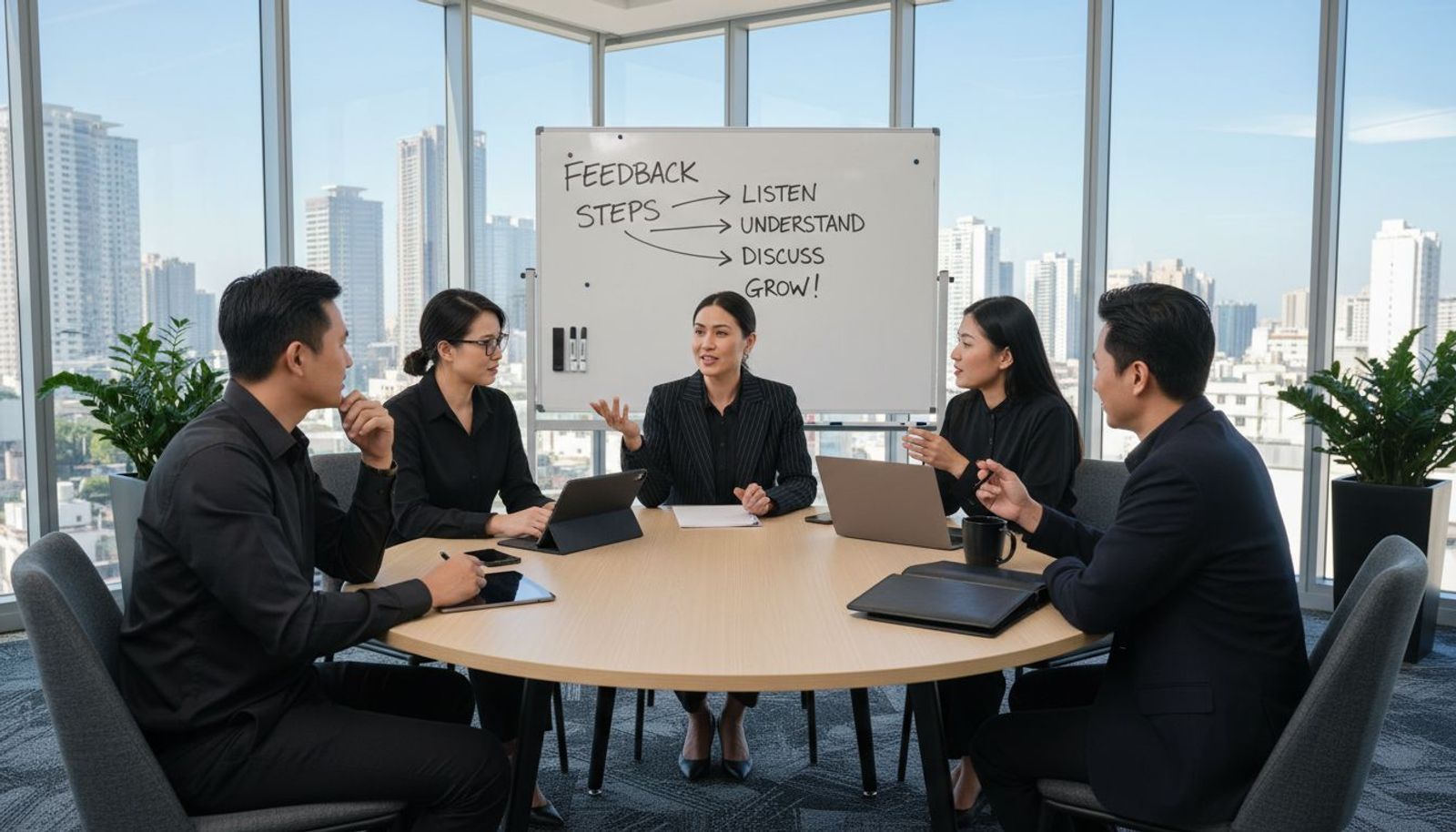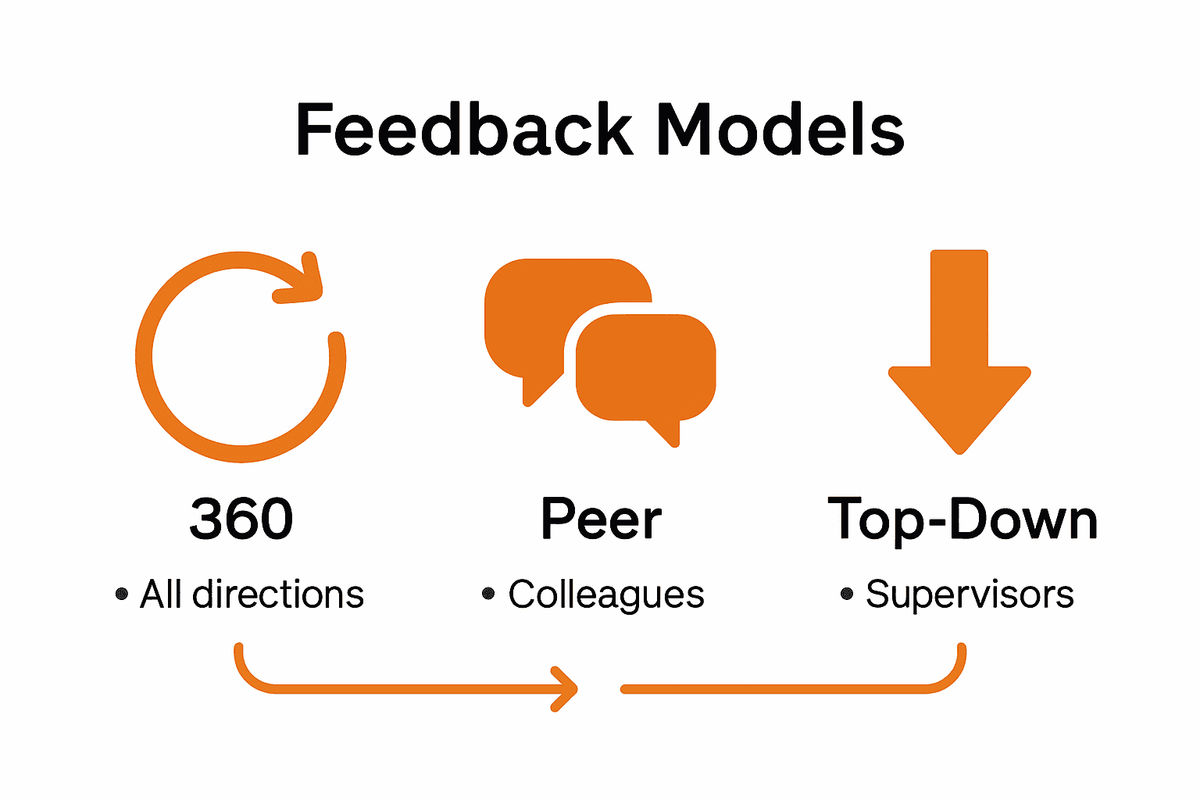Team Feedback Process: Complete Guide for Managers
November 19, 2025

Over 70 percent of organizations now rely on team feedback processes to boost collaboration and performance. In workplaces where open communication matters, how teams gather and respond to feedback can make or break progress. Knowing the ins and outs of structured feedback helps leaders create stronger, more engaged teams built on trust and growth. This guide unpacks what makes an effective team feedback process and how to put it into action for real results.
Table of Contents
- Defining The Team Feedback Process
- Major Types Of Team Feedback Models
- Key Steps In Effective Feedback Loops
- Best Practices For Using Feedback Tools
- Common Challenges And How To Avoid Them
Key Takeaways
| Point | Details |
|---|---|
| Importance of a Comprehensive Feedback Process | A modern team feedback process integrates multiple perspectives for holistic performance insights, focusing on transparency and continuous improvement. |
| Types of Feedback Models | Various structured models, such as 360-degree and peer feedback, promote open communication and collaborative learning among team members. |
| Steps for Effective Feedback Loops | Establishing psychological safety, defining clear objectives, and facilitating structured discussions are crucial for developing effective feedback loops. |
| Challenges in Implementation | Common challenges include defensiveness and bias, which can be mitigated through structured debriefs that create a safe space for honest dialogue. |
Defining the Team Feedback Process
A team feedback process is a systematic approach for gathering, analyzing, and sharing performance insights across an organization. Unlike traditional top-down performance reviews, modern feedback mechanisms incorporate multiple perspectives and aim to create a comprehensive understanding of team dynamics and individual contributions. According to research from Wikipedia, this approach differs significantly from conventional performance evaluations by integrating perspectives from colleagues, supervisors, and even external stakeholders.
The core objectives of a team feedback process include promoting transparency, encouraging continuous improvement, and fostering open communication. Key components typically involve:
- Collecting input from multiple organizational levels
- Providing constructive and specific observations
- Creating a safe environment for honest dialogue
- Establishing clear evaluation criteria
- Developing actionable development recommendations
Recent advancements in feedback methodologies have introduced innovative approaches to gathering insights. arXiv highlights emerging AI-driven techniques that can analyze team interactions and deliver personalized feedback, potentially revolutionizing how organizations understand and optimize team performance. These technological solutions aim to provide more nuanced, data-driven perspectives that go beyond traditional subjective assessments.
Successful implementation requires careful design and a commitment to creating a culture of mutual respect and continuous learning. Team Communication Improvement Tips can provide additional strategies for ensuring that feedback processes remain constructive, respectful, and focused on collective growth rather than individual criticism.
Major Types of Team Feedback Models
Team feedback models represent structured approaches to gathering and analyzing performance insights, each with unique characteristics and strategic objectives. 360-Degree Feedback stands out as a comprehensive model that fundamentally transforms traditional performance evaluation methods. According to Wikipedia, this approach involves collecting performance data from multiple stakeholders, including peers, subordinates, supervisors, and sometimes external contacts, creating a holistic assessment of an individual's professional capabilities.
The primary team feedback models include:

- 360-Degree Feedback Model: Comprehensive multi-perspective assessment
- Peer Feedback Model: Collaborative evaluation among team members
- Top-Down Feedback Model: Traditional hierarchical performance review
- Self-Assessment Model: Individual reflection and personal performance analysis
- Upward Feedback Model: Subordinates providing insights about managers
Interestingly, Wikipedia highlights the Peer Feedback Model as a particularly dynamic approach, which enables team members to offer constructive observations directly to one another. This model fosters a two-way communication process that encourages collaborative learning, mutual understanding, and shared growth. By creating an environment where feedback flows horizontally across team members, organizations can develop more transparent and supportive workplace cultures.

Implementing these feedback models requires careful consideration of organizational culture, team dynamics, and individual comfort levels. Team Development Explained: Stages, Tools, and Best Practices offers additional insights into selecting and integrating the most appropriate feedback approach for your specific team context.
Key Steps in Effective Feedback Loops
Constructing an effective feedback loop requires a strategic approach that goes beyond simple performance assessment. Research from Frontiersin highlights the critical role of team reflexivity, where members openly share and discuss their work experiences, creating an environment of trust and continuous improvement. This collaborative process transforms feedback from a potentially threatening interaction into a constructive dialogue focused on collective growth.
The key steps in developing a robust feedback loop include:
- Establish Psychological Safety: Create an environment where team members feel comfortable sharing honest observations
- Define Clear Objectives: Outline specific goals and expectations for the feedback process
- Collect Comprehensive Data: Gather insights from multiple perspectives
- Facilitate Structured Discussions: Conduct purposeful feedback sessions
- Develop Actionable Recommendations: Transform insights into concrete improvement strategies
- Monitor and Follow Up: Track progress and maintain ongoing dialogue
According to NCBI, team debriefs play a crucial role in this process. These structured sessions allow teams to systematically review performance, identify successful strategies, and pinpoint areas requiring development.
 By creating a consistent mechanism for reflection, organizations can transform feedback from a periodic event into a continuous learning experience.
By creating a consistent mechanism for reflection, organizations can transform feedback from a periodic event into a continuous learning experience.
How to Manage Team Dynamics for Optimal Collaboration can provide additional insights into creating an environment where feedback becomes a natural, supportive part of team interaction.
Best Practices for Using Feedback Tools
Navigating the complex landscape of feedback tools requires strategic implementation and a nuanced understanding of team dynamics. According to research from Academic Oxford, leveraging 360-degree feedback tools demands careful consideration of both technological capabilities and human interaction patterns. The most effective tools are those that seamlessly integrate data collection with meaningful, constructive dialogue.
Key best practices for maximizing feedback tool effectiveness include:
- Customize Tool Parameters: Align tool settings with specific team objectives
- Ensure Anonymity: Create safe reporting environments
- Set Clear Expectations: Communicate tool purpose and usage guidelines
- Train Team Members: Provide comprehensive orientation on tool functionality
- Establish Regular Review Cycles: Create consistent feedback intervals
- Maintain Data Privacy: Implement robust confidentiality protocols
Research from Link Springer highlights the critical importance of feedback literacy, emphasizing that tools are most effective when users understand how to provide and receive constructive observations. This requires ongoing education and a cultural commitment to transparent, respectful communication.
Managers seeking to optimize their approach can gain additional insights from Understanding the Role of Technology in Team Building, which explores how technological solutions can enhance team communication and performance evaluation strategies.
Common Challenges and How to Avoid Them
The team feedback process can be fraught with complex interpersonal dynamics that challenge even the most experienced managers. Research from Frontiersin reveals that team reflexivity plays a crucial role in overcoming feedback barriers, emphasizing the need for a collaborative environment that encourages open and constructive communication.
Common challenges in the feedback process include:
- Defensive Reactions: Team members feeling personally attacked
- Bias and Subjectivity: Difficulty maintaining objective assessments
- Communication Gaps: Misunderstandings in feedback delivery
- Fear of Repercussions: Reluctance to provide honest observations
- Inconsistent Feedback Mechanisms: Lack of standardized evaluation approaches
According to NCBI, structured team debriefs are a powerful strategy for addressing these challenges. These systematic review sessions allow teams to create a safe space for honest dialogue, transforming potential conflict into opportunities for collective growth and improvement. By implementing consistent, well-designed feedback protocols, organizations can mitigate defensive responses and foster a culture of mutual respect and continuous learning.
Managers looking to navigate these complex interpersonal dynamics can find additional guidance in Why Team Challenges: Complete Guide for Managers, which offers insights into creating more resilient and communicative team environments.
Strengthen Your Team Feedback Process with Fun and Engagement
Navigating the challenges of a transparent and effective team feedback process can feel overwhelming. When teams struggle with communication gaps or defensive reactions, fostering an open and trusting environment becomes crucial. The key pain points include promoting psychological safety, encouraging continuous dialogue, and keeping feedback constructive and team-focused. Incorporating engaging and customized team activities can play a pivotal role in overcoming these hurdles by building cohesion and open communication naturally.

Discover how quizado.com offers a dynamic solution to enrich your team feedback loops through interactive quiz games tailored for corporate teams. Our platform helps managers create personalized experiences that transform team-building into enjoyable, memorable moments that spark collaboration and trust. By integrating these activities alongside your feedback strategy, you can effectively reduce communication barriers and encourage honest conversations. Start turning your feedback sessions into opportunities for collective growth by exploring How to Manage Team Dynamics for Optimal Collaboration and Why Team Challenges: Complete Guide for Managers on our site. Take the next step to empower your team with meaningful engagement today at https://quizado.com.
Frequently Asked Questions
What is the team feedback process?
The team feedback process is a systematic approach for gathering, analyzing, and sharing performance insights across an organization, integrating multiple perspectives for a comprehensive understanding of team dynamics.
What are the key components of an effective team feedback process?
Key components include collecting input from multiple organizational levels, providing constructive observations, establishing a safe environment for dialogue, and developing actionable recommendations.
What are different types of team feedback models?
Different types of team feedback models include 360-Degree Feedback, Peer Feedback, Top-Down Feedback, Self-Assessment, and Upward Feedback, each serving unique purposes in performance evaluation.
How can managers avoid common challenges in the team feedback process?
Managers can avoid common challenges by establishing structured team debriefs, creating a safe space for dialogue, providing regular feedback mechanisms, and promoting a culture of mutual respect and continuous learning.
Recommended
- Team Development Explained: Stages, Tools, and Best Practices - Blog
- 7 Effective Employee Engagement Ideas for Managers - Blog
- How to Foster Teamwork for Stronger Corporate Collaboration - Blog
- Understanding the Managers Team Building Guide - Blog
- Boom - Free Screen Recorder & Video Editor
- How to Monitor Outsourced Staff for Maximum Efficiency | NineArchs



